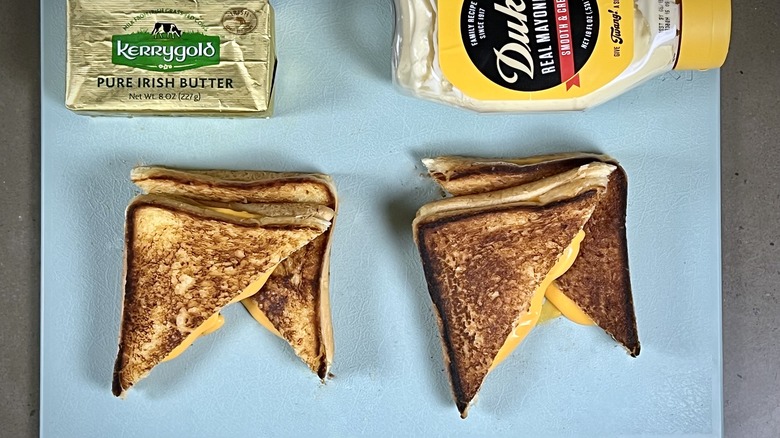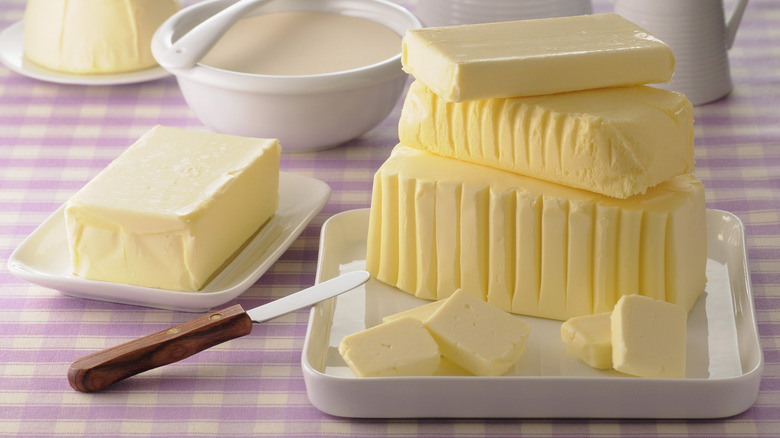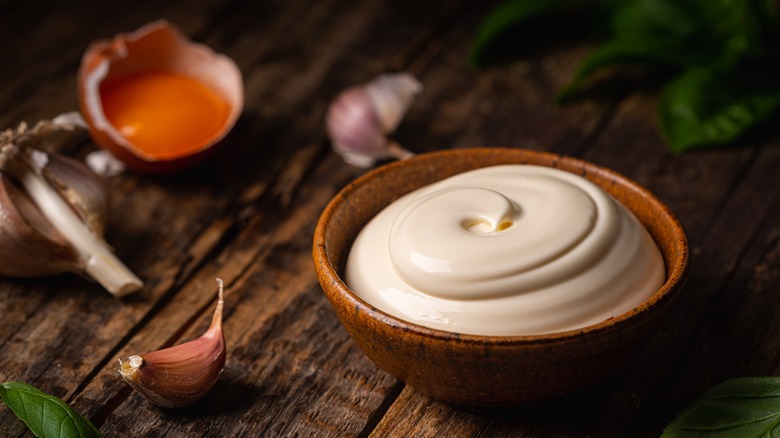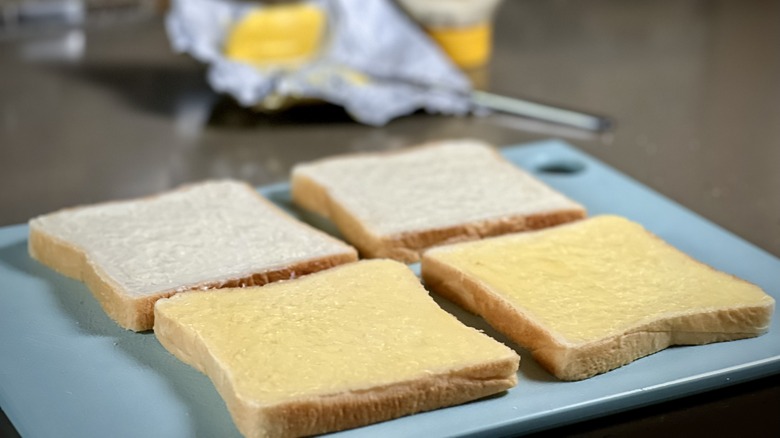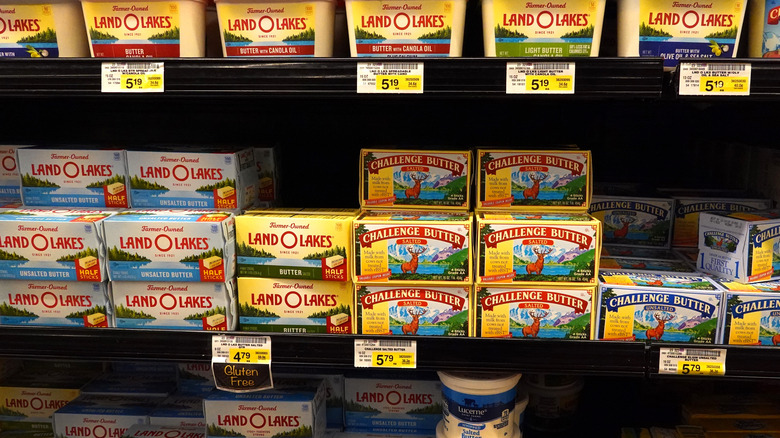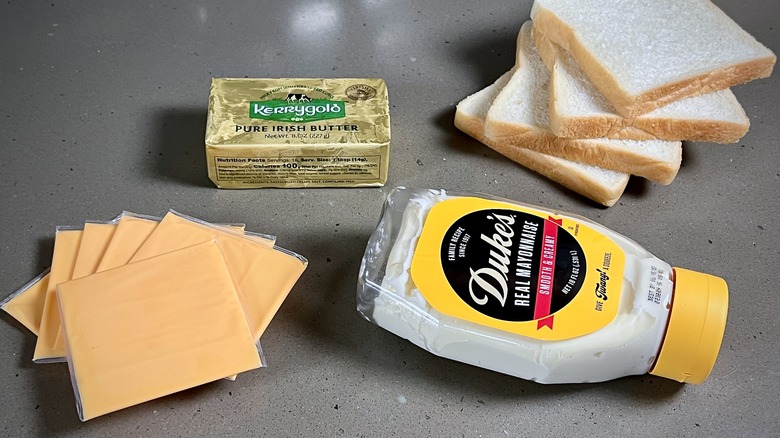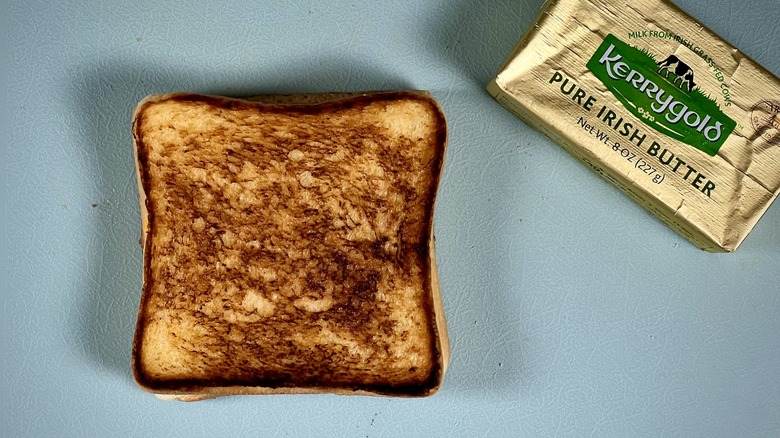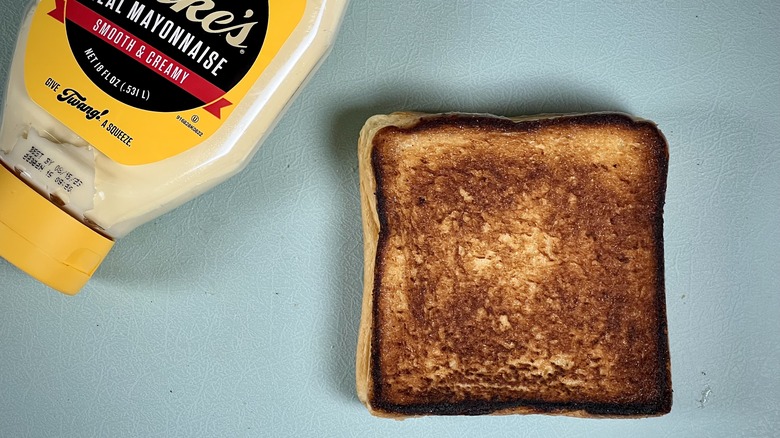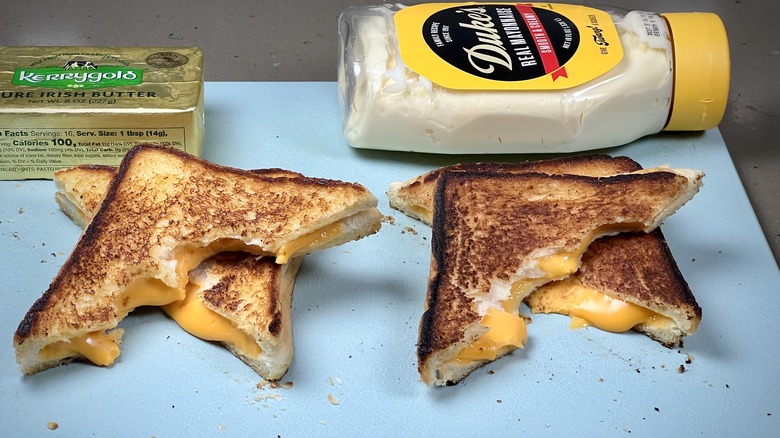Butter Vs. Mayo: We Resolve The Debate Over Which Makes A Better Grilled Cheese
There are a lot of opinions out there about how to make the ultimate grilled cheese. Enthusiasts have opinions about every component, from the type of bread to choose — basic white, flavorful sourdough, thick Texas toast — to the perfect mixture of cheeses that create an ooey, gooey melted interior. Today's hot topic relates to the fat used to coat the bread before it hits the skillet, affecting this incredible sandwich's crispy, browned exterior.
The classic method uses butter, but some cooks swear by slathering the bread with mayonnaise instead. We were determined to identify the best method, so we whipped up two identical grilled cheese sandwiches made with Japanese shokupan milk bread and American cheese slices, cooking them on a nonstick skillet over medium-low heat. The only difference between the two? We coated one with softened, salted Kerrygold butter and the other with Duke's mayonnaise.
Our tasters evaluated each sandwich on various factors: ease of spreading, whether the sandwich required advanced prep, flavor, aroma, color, texture, evenness of browning, and whether the exteriors felt greasy. Both sandwiches tasted fantastic, and we found that one tasted better while the other was easier to make.
Why butter is the classic choice
Butter is the conventional choice when it comes to making grilled cheese sandwiches. It's naturally rich because of its high milk-fat content, and anyone who has made brown butter knows that the flavor deepens when it's cooked. That's because the milk solids separate from the fat when butter melts, creating a toasted flavor that infuses the grilled cheese with an unmistakable decadence.
The major caveat with this method is that you can't use butter straight out of the refrigerator because it's too hard, making it difficult to spread and increasing the chance that you'll tear holes in the delicate bread. You'll want to plan on about an hour on the counter for butter to soften, so make sure to plan ahead.
When it comes to making grilled cheese, we suggest using salted butter. Added salt is beneficial here because it helps accentuate the butter's richness. You may not have it on hand, though, because most people bake with unsalted butter. If you don't, there's no need to stress; you can sprinkle a little salt on the butter after spreading it to achieve a similar result.
Mayo has its advantages
Mayonnaise has become a recent favorite for toasting bread, and for a good reason. It's easy to spread, and it's naturally soft, so you can use it straight out of the refrigerator. It has a high oil content that promotes browning as well as butter, and cooking with it creates a pleasant eggy-flavored coating to the bread.
One of the major reasons cooks prefer using mayonnaise here is because of its high smoke point. Butter has a relatively low smoke point, which means it starts to smoke and burn between 302 to 350 F. If you're not careful, the butter can burn before the cheese has melted. Oil-based mayonnaise is much more heat-resistant, and it won't start to smoke until it reaches 450 F (via Firefighter Inside). While it is possible to burn mayonnaise, it would require much hotter temperatures compared to cooking with butter.
It's important to note here that not all mayonnaise is created equally. For our taste test, we used full-fat mayonnaise (specifically, Duke's, because that's what we had on hand). Using low-fat mayonnaise, vegan mayonnaise, or Miracle whip may result in sandwiches that don't brown as well.
What about the nutrional facts?
We looked at the labels on the products we used for the test, and the nutrition is fairly similar. A tablespoon of salted Kerrygold butter contains 100 calories, 11 grams of fat, 7 grams saturated fat, 30 milligrams of cholesterol, and 100 milligrams of sodium. A tablespoon of Duke's mayonnaise also contains 100 calories, with 12 grams of fat, 2 grams of saturated fat, 10 milligrams of cholesterol, and 70 milligrams of sodium.
Before making a decision about which fat is healthiest for you, it's best to have a conversation with your doctor about your recommended levels of saturated fat. Mayonnaise does have lower levels of saturated fat, but the type of saturated fat found in butter may not be as unhealthy as we once thought. It contains an essential fatty acid known as C15:0 (also called Pentadecanoic acid) that may be linked to health benefits like reducing inflammation, a reduced risk of heart disease and diabetes, and managing depression.
The price difference between mayonnaise and butter
When we purchased our ingredients for this taste test at our local Fred Meyer grocery store, an 8-ounce stick of butter cost $5.49, and the 18-ounce bottle of mayonnaise was $5.99. That put the butter at roughly $0.69 per ounce and the mayonnaise at $0.33 per ounce. Of course, the price of these products varies greatly based on the brand. There are several different types of butter, and Irish butter (like Kerrygold) isn't exactly the cheapest option. The same quantity of generic butter cost only $2.40 (or $0.30 per ounce), and generic mayonnaise cost much less than the Duke's brand name bottle ($3.29 for a 15-ounce squeeze bottle, or $0.22 per ounce).
Comparing the two products' pricing shows that mayonnaise is less generally expensive than butter, though. If you're looking to save money, using mayonnaise may be the way to go when making grilled cheese sandwiches at home.
The other ingredients for our taste test
Butter and mayonnaise aren't the only considerations when making grilled cheese. It all starts with choosing the right bread. In our experience, soft, white bread is the best way to go. Chewy sourdough, hearty wheat bread, or crusty artisanal options add flavor and texture to sandwiches, but that's not necessary for grilled cheese. The added flavor detracts from the cheese inside, and tough crusts can become too sharp and shred the roof of your mouth when toasted. Our preference is Japanese shokupan milk bread, but old-school Wonder bread works well here, too.
The next consideration is the cheese. You'll want a good melting cheese — like American cheddar, mozzarella, or fontina — to ensure it melts before the bread burns. You can put a lid on the pan to trap heat inside, speeding up the melting process, or pop the sandwich into the oven to finish the job when the bread reaches the perfect level. But, if you're looking to avoid any extra steps and you don't feel the need to get fancy with it, just use American cheese. It melts quickly and it tastes great.
Choosing the right pan for grilled cheese
The final consideration is the pan you'll use to cook the sandwich. In our experience, a non-stick pan will help you make the best grilled cheese. These pans are generally coated with PTFE (previously known as Teflon) or ceramic coatings, creating a slippery surface that prevents foods from sticking. This is good news for your grilled cheese, as any escaped grated cheese or unbuttered surfaces won't stick when it's time for the flip.
Non-stick pans also heat up quickly and retain their heat well, and we've found that grilled cheese sandwiches brown evenly in these conditions. You could use a well-seasoned cast-iron skillet, which would also have a nonstick surface, but these pans take a while to heat, and they're not known for even heating. Stainless steel skillets would be our last choice, as food tends to stick to their surface without the addition of extra oil.
How it went cooking with butter
We took the butter out of the fridge the night before the tests so it was sufficiently softened. That made it easy to spread from end to end in a nice, even layer. If we had forgotten this step, the spreading process would have been a complete nightmare!
Once the pan was preheated, we added the bread butter-side-down. It started sizzling as soon as it hit the hot surface, but the melted butter was contained underneath the bread without spreading beyond the edges of the sandwich. On our first flip, we noticed the bread was browning evenly between the edges and the center, although there were some spots that remained untoasted. It took a second flip and some light pressing with a spatula to promote browning throughout the entire surface. We also observed some smoke in the pan around the two-minute mark. The butter had reached its smoking point, but it also smelled amazing, so we didn't complain too much.
How it went cooking with mayonnaise
The mayonnaise was extremely easy to spread on the bread straight out of the refrigerator, which we appreciated. It was thick and viscous, so we had to take extra care to spread it in an even layer. It had a tendency to be gloppy in some areas and thin in others.
As soon as it hit the preheated pan, the mayonnaise started bubbling at the edges of the bread. Anyone with an aversion to mayonnaise might want to step out of the kitchen now; once heated, the whole area smelled intensely of mayo. Over time, the heat also released the condiment's oil, which spilled out from the sides of the bread. We had to move the sandwich around the pan to collect that excess oil so it would brown evenly.
After the first flip, we observed that the edges were browning faster than the middle, but the middle was also heating fairly evenly. A light press on the middle of the bread helped keep the outsides from getting too dark. We noted that the pan didn't smoke at all during the entire cooking process.
The verdict: Which spread is best for grilled cheese?
Let's start with what both sandwiches did well: The butter and mayo versions turned a gorgeous, golden brown color in the same time that it took the American cheese to melt. They both had a fantastic, crusty texture, although the mayonnaise grilled cheese left more grease residue on our fingers after eating. Most importantly, they both tasted great. The butter brought a rich flavor that greeted us with familiar, caramelized notes; the mayonnaise had a slightly eggy taste, a pleasant lingering tanginess, and was overall more complex than the butter.
Taking all those factors into consideration, the mayonnaise grilled cheese was our overall winner. It displayed more even browning than the butter-slathered sandwich and didn't require any advance prep work. That said, our taste testers actually preferred the flavor of the grilled cheese prepared with butter. The sweet nuttiness of the brown butter caramelization was hard to beat. (Another bonus, it was less greasy than the mayo version.) When asked if they would eat either grilled cheese again, our tasters responded affirmatively for both sandwiches, so it's hard to call either one a loser.
